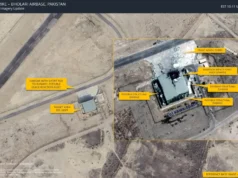Full inspection needed after US Osprey crash off Japan island

A U.S. Marine Corps Osprey aircraft
In the wake of the fatal crash of a U.S. Air Force CV-22 Osprey transport aircraft off the island of Yakushima in Kagoshima Prefecture, questions and concerns are spreading over the Ospreys’ safety. Along with all-out rescue measures, every Osprey in the country should be grounded for thorough inspections.
The crash occurred just as the Osprey was heading for Kadena Air Base in Okinawa Prefecture after taking off from Marine Corps Air Station Iwakuni in Yamaguchi Prefecture. According to witness accounts, the Osprey suddenly flipped over, with one of its engines on fire before plunging into the ocean.
This is the first fatal accident involving an Osprey aircraft in Japan. Of the eight crew members, one man was rescued immediately after the crash but was soon confirmed dead.
In Japan, a total of 44 Ospreys of three types are deployed in the U.S. military and the Japanese Self-Defense Forces. These aircraft share the same basic structure and performance. If malfunctions or structural flaws were to blame for the latest accident, the remaining Ospreys could follow the same fate.
The Japanese government has urged the United States to ground its Ospreys until their safety is confirmed, with an exception for their use in search and rescue operations. The request, made the day after the deadly crash, should have come much earlier.
Ospreys were first deployed in Japan in 2012. The aircraft features both the properties of a helicopter capable of vertical takeoff and landing and a fixed-wing plane that can fly at high speed. They were prone to accidents during the development phase, but mass production eventually began after claims their safety had been ensured.
However, major accidents have continued to occur. In 2016, an Osprey made a crash landing off Nago, Okinawa Prefecture, leaving the aircraft wrecked and two crew members injured. Japanese authorities were barred from conducting a thorough investigation due to stipulations in the Japan-U.S. Status of Forces Agreement (SOFA), which became a point of contention.
In the wake of the latest accident, the Japanese government initially used the phrase “emergency landing on water,” in line with the United States’ explanation. There is no way public anxiety can be eased if the government employs such rhetoric. Japan is urged to get involved in the accident’s investigation to the maximum extent possible within the scope of SOFA. Tokyo also needs to persistently demand revisions of the controversial bilateral agreement with Washington.

As China continues its military expansion, Osprey deployments are said to help bolster Japan’s defense of the Nansei Islands. Yet with this incident, fears are bound to grow over the possibility the aircraft may crash in urban areas. The Japanese government plans to relocate the Ground Self-Defense Force’s Ospreys to Saga Prefecture in 2025, but it may not be able to win local understanding without facing their worries.
To prevent a recurrence, it is imperative to uncover the cause of the accident and adopt viable countermeasures. It is also essential to disclose information to the public. The Japanese government is urged to work closely with the U.S. government from the standpoint of maintaining trust in the bilateral alliance.




